An Egg In Every Hue: The Secret to Getting Various Egg Colors
Egg colors are determined by the breeds of the chickens. Learn how to breed chickens for specific egg colors to add pizzazz to your basket.
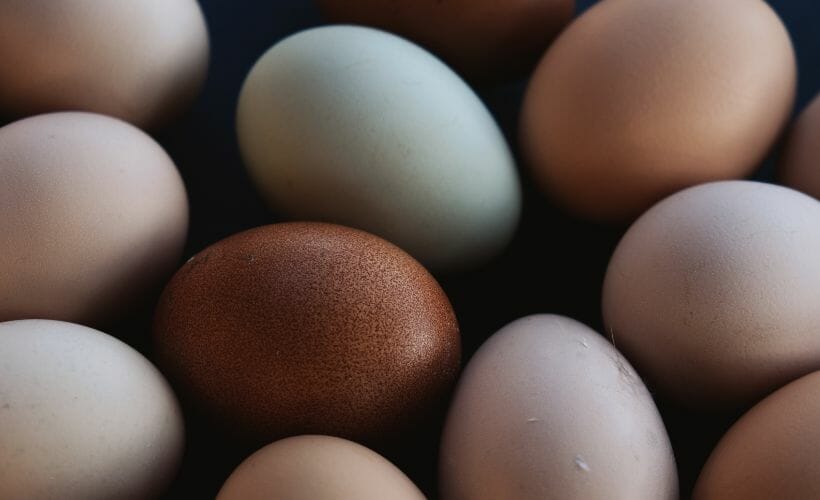
Last week we brought you The Anatomy of Egg Color and it was a huge hit. Now we’re back for more. Remember how we talked about the core color of every egg being white or blue? That knowledge is going to help us play artists and create awesome colors. To breed chickens for a specific color egg (or any desired trait), you need to do your homework on the various breeds. I’m going to give you a few common breeds to work with, but the information you will need is only a Google search away.
Genetics for Egg Colors
For those of you who have been out of high school for a while, here are some key points from biology class that you’ll need to know.
Dominant Genes: The genes that “show” (in our case the egg color that you see)
Recessive Genes: The genes that are “hidden” (in our case an egg color we don’t see)
These terms may not be incredibly important for today’s lesson, but they do play a part.
Mixing Egg Colors
As mentioned in The Anatomy of Egg Color, brown is merely a paint added to white eggs towards the end of the laying cycle. I have tried numerous times to put into words how all of this color mixing works and I haven’t been able to come up with a way to make it clear, so it’s picture time.
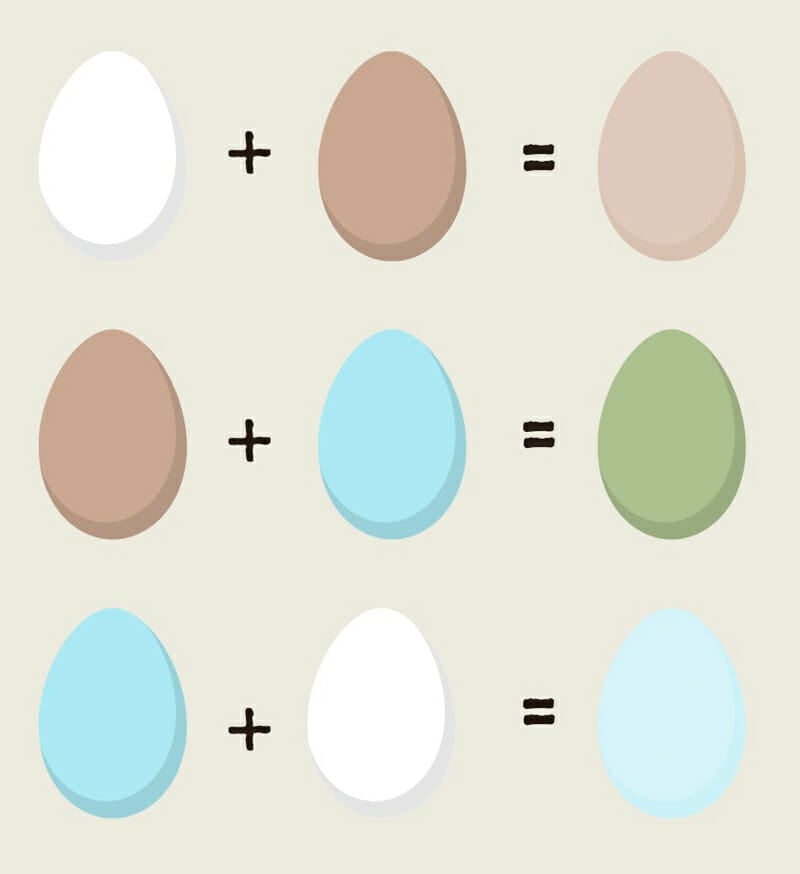
Once you have your basics, you can take it one step further by breeding offspring back to a parent or adding a new breed (egg color) to the mix; you will get a new egg color.
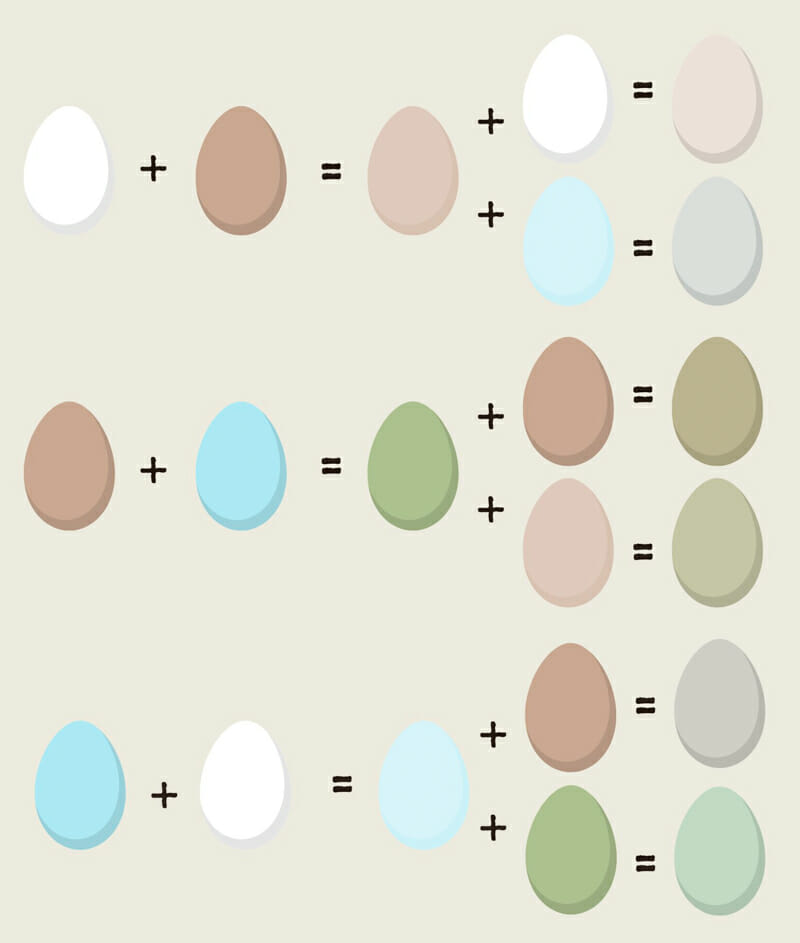
Using Good Breeding Stock
When breeding for egg color, the parent birds’ genetics are very important. You’ll notice when I bred back to one of the parent colors in the diagram above, the resulting egg color was a shade between the two original parents. When you are working to improve color or trying to attain a certain color you need to know the parents come from good stock. This is especially true if you are buying a new bird for breeding stock that isn’t laying yet or is male. Easter Eggers are common birds used for mixing and matching egg colors, but they are not a true breed (it’s a common term for any breed mixed with an Araucana) and can produce unreliable egg colors.
If you want to create an Olive Egger (usually a mix between an Araucana and a Marans) and either of your birds does not carry the genes for the strong desired egg color, you won’t get the results you are hoping for. Sometimes it takes several generations to get the desired color. You may get a green egg and want more of an olive, you would have to breed the green-laying bird with a bird that carries the genes for dark brown eggs.
I Promised Science
Okay, I promised you science, but did I deliver? Yes and no. The system I showed you is basic. More issues can come into play. Remember those dominant and recessive genes I was telling you about earlier? A recessive gene can lay hidden for several generations and pop up at any given time. Unless you have paperwork on the bird’s parentage that goes back to basically the beginning of time, surprises may happen.
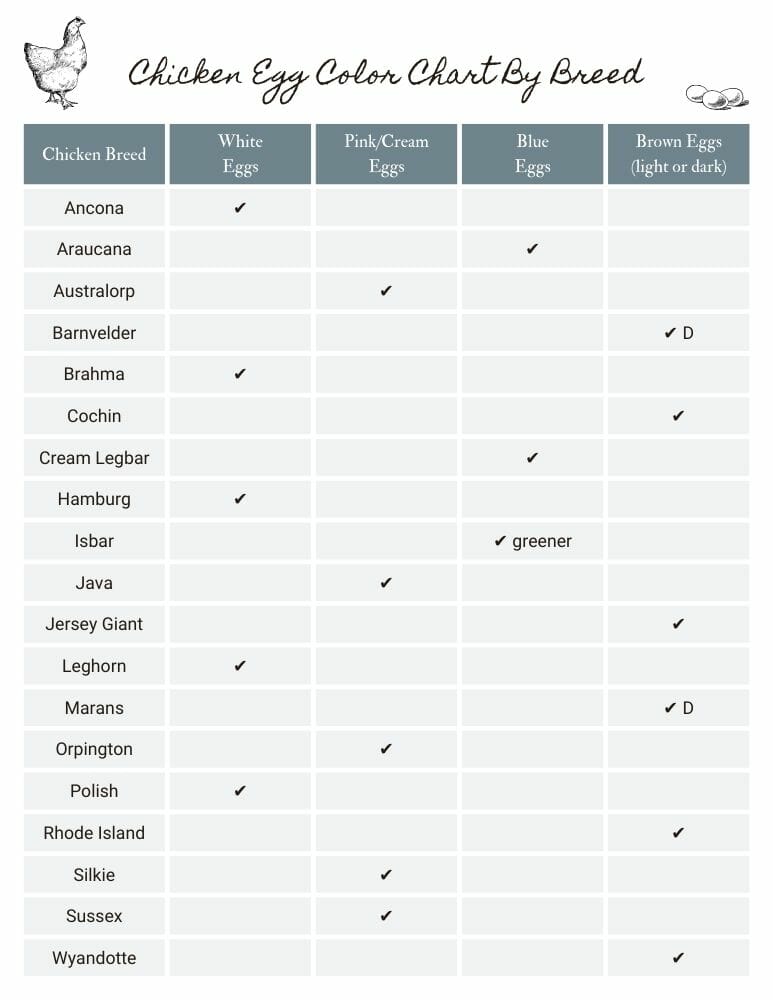
Another aspect that comes into play is protoporphyrin (or what I referred to as “brown paint”). Protoporphyrin is largely controlled by genetics, but the hen itself may affect the shade of brown as well. Environment, health, and diet can all affect how much protoporphyrin a hen produces when she lays. You could take two identically brown egg layers, breed them and get a new shade of brown.
What color is the healthiest egg?
Brown is best is a myth. The color of the shell does not affect the nutrient content. There is no nutritional difference between eggshell colors. Regardless of the outward appearance, the inside of all eggs remains the same (health of the chicken aside, obviously).
Do different colored eggs taste the same?
Like with the nutrition of eggs, the taste is also the same regardless of the eggshell color. The pigments have no effect on flavor.
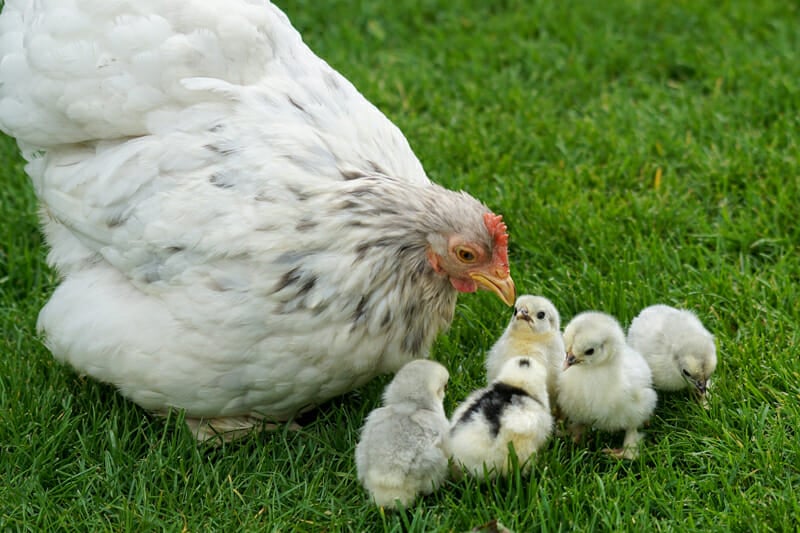
Why Breed for Various Egg Colors?
As mentioned before, some people breed for egg color to improve breed standards. Two great examples are Araucanas (see their color guide) and Marans (see their color guides). Most hobby farmers breed for egg color because it’s just plain fun. I have a flock of fourteen laying hens and each lays a unique colored egg. I love it because it adds diversity to my egg basket, appeals to my egg buyers, and I know who laid what when there is a problem. When my sea foam green eggs start showing up with thin and brittle shells I know to keep a closer eye on Greycie to see how she’s eating and if there are any health concerns.
Have you tried your hand at breeding for egg color? What fun colors have you created?
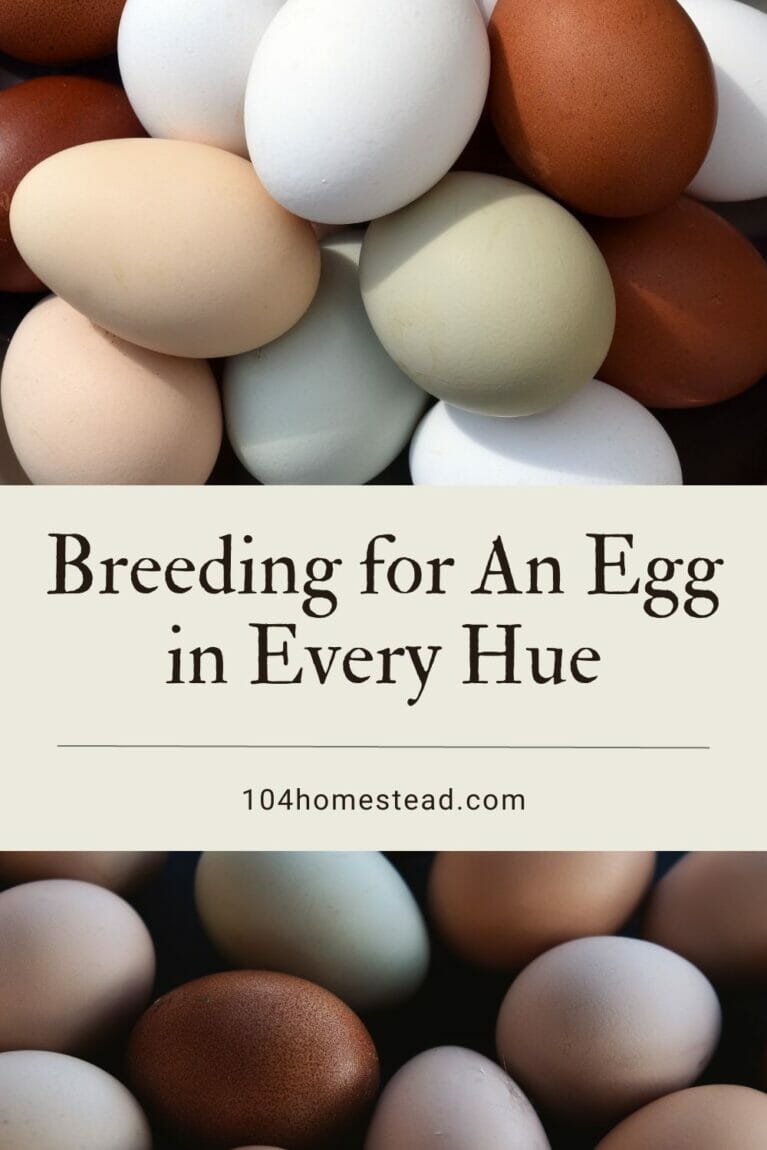

I bred my light Brahma rooster to my bluish/green easter egger hens. Any idea what colour eggs I’ll get when those mixed girls will lay. They haven’t started yet so thought I’d ask. The Brahma lay a light brown egg. The Easter Eggers eggs aren’t blue but they aren’t green either, pretty none the less!
Bought some chicks at an auction, seller said they are araucana hens crossed with cemani roosters. What egg colors can I expect? Most are black with a little white some blue.
I would think anything between a light blue to a dark green, but I’m not entirely sure.
Hi,
Cemani lay a light brown egg, so the Araucana/Cemani mix would make a light mint green. That being said, VERY few people have Araucanas (rare breed) and use that name interchangably with Ameraucana (pure breed) Easter Egger (mutt).
The end result for the shell color will be the same if an Ameraucana is used, and it’s a coin toss if an Easter Egger was used (you could get brown eggs).
Long answer to a short question, HTH.
I’m still a little curious. I hatched a chick which was a mix of my rooster who is a Black copper Marans and one of my tan colored eggs (not 100% sure who it’s from). This morning I pulled out a tiny speckled olive colored egg. Is it possible, if my EE who lays tan eggs, was the mother of this chick could have passed on a recessed blue gene?
I bred my Olive egger rooster with a cream legbar mix hen who lays very light cream eggs. She came out of the incubator with a crest and leg feathers already. Super excited to see what she’ll look like. The olive egger roosters mom is a light blue laying Easter egger and his dad is a welsummer. What color eggs do you think this new chick will lay? I’m guessing it’s going to be a very light green unless her grandmas blue egg comes through. Thoughts?
Hi,
I have a Brahma rooster and two Easter Eggers that lay blue eggs. If I hatch their eggs what color would the new chicks lay? Green?
Hi. I mixed a copper moran rooster with green eggers and get eggs a pretty bronze colour
What if you have a copper Marran and a Sussex rooster
I’m currently breeding a mosaic cross rooster (pale cream egg DNA) with my true blue egg Americaunas – looking to hatch out EE that lay pale blue, mint or other in between shades.
Hey there, hope you’re still following this forum. What about taking a green egg layer to a blue egg layer? Will that get blue or green or possibly in-between.
I am also interested in this I have a green egg layer and a rooster that is amerucaunax maran what Color egg will I get ??
I have…probably 100 lol…questions!! I have a flock of (baby) Rhode Island Blues (RI red crossed w/Black Australorp), Cuckoo Marans, Golden Laced Wyandottes, Buff Orpington, and a mix named Starlight Green Eggers (Prairie Bluebell crossed w/unspecified brown layer).
If my understanding is correct…
RI blues would carry two brown genes thus brown eggs.
SG eggers would carry one blue and one brown color gene? So they’re eggs could be either blue, brown, or any shade in between? Feed guy said green eggs but is that a *given*
Now this is where I get confused….
I just acquired two (very beautiful) young, cream legbar roosters. So now we have a blue gene carrying Dad..blue jeans…maybe that will be ones name…haha..sorry ?
Anyhooo….
*Dad (Blue Jeans) + SL egger = (one blue gene and one either brown or blue?) So more blue? Green? Olive? Any of the above? Based on the egg color, and I hatched it, could I possibly make an educated guess as to the color of eggs the offspring would lay? If I hatched a blue egg then that chick got two blue genes, correct?
**Blue Jeans + my other brown egg layers = my “own” Starlight Green eggers? And so continues the above….
Last question I swear! Are Starlight green eggers just a fancy name for Easter Eggers??
Hi there,
Love your article !! I am still a bit foggy about this, and that is if i have a bird laying say, light blue eggs, and i want to intensify that color to a more deep shade of blue, what do i do ?
First i must say i will be mating white leghorns with a Cream legbar to get the light blue eggs i have been told, so do i take the youngsters back to the sire to get a deeper shade of blue ?
Thanks
nino
Yes, breed back to the Legbar. You’ll also want to only hatch the bluest eggs. Keep in mind, though, that Cream Legbars are lightly tinted blue. For true blue you’ll need one of the breeds mentioned above.
You will need to mix either light blue with blue or LB with more LB. you could look at some darker colors too to intensify the blue but they might steal the blue.
I ordered a mixed assortment in the fall plus some Easter Eggers as that was all that was available at the moment my guy said Go. It is not what I would have ordered if more had been available but it has been so much fun! The pullets have just begun laying and in the first two days I have brown, blue, white and olive eggs!! Besides the EEs, my flock includes black Australorps, white Leghorns, RIRs, New Hampshire Reds, an Ancona, a Silver Spangled Hamburg, a black Jersey Giant and some other grey and white hen I still haven’t identified. Great article!
I have a post pinned to the top of my Facebook Page for people wondering the breed and gender of their chicken. Feel free to add your mystery hen to it.